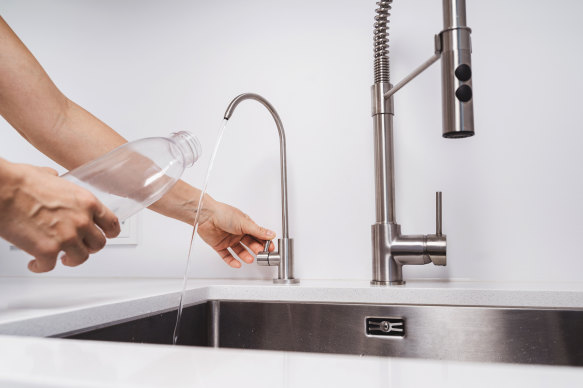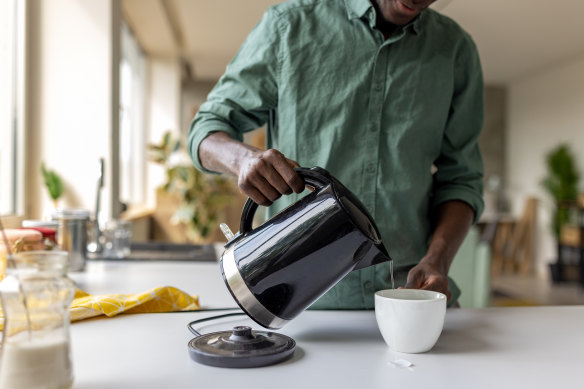This was published 4 months ago
5 ways to filter your tap water at home
By Sarah Berry
New testing has detected “forever chemicals” in Sydney’s water supply. This masthead reported that Sydney Water took samples from the local drinking water catchments, and while PFAS concentrations are within Australia’s drinking water guidelines, they are above US safety thresholds.

Do you need a water filter at home? It’s unlikely.Credit: Getty Images
PFAS is an umbrella term for a family of thousands of chemicals dubbed “forever chemicals” because they never break down in the environment.
We have many sources of exposure, including through our food packaging, household dust, furniture, carpets and upholstery, raincoats, artificial grass, non-stick frying pans, cosmetics and even dental and menstrual products, which have been treated with PFAS to make them stain or water-resistant.
The question on many people’s lips now is whether our tap water still safe to drink?
“The answer is yes,” says Professor Stuart Khan, the head of the school of civil engineering at the University of Sydney. “Sydney still has one of the best water supplies in the world and one of the safest drinking water supplies in the world.
“Exposure through Sydney’s drinking water is a very, very minor source – these are very small trace concentrations,” Khan says. “They certainly add to our overall PFAS burden, but not in a way that drives the risk.”
While expert opinion is that tap water is safe, for those who do want to buy a water filter, there are several options and considerations to make.
Prices range from $18 to $30 for filtration bottles; $20 to $75 for filtration jugs; $25 to $80 for tap-mounted filters; $60 to $450 for benchtop filters; $180 to $600 for under-sink filter systems; to more than $4000 for a whole-house system. These prices do not include regular replacement of filters, maintenance or the re-plumbing needed for under-sink or whole-house options.
Look for NSF certification to ensure the filter does what the manufacturer claims, and if you opt for under-sink or tap filters, flush them for 10 seconds before use to remove any bacterial build-up.
Whatever system you opt for, the filtration method is what makes the difference for PFAS removal. Here are your options.
Reverse-osmosis
Reverse osmosis filters use a thin membrane to separate the clean water from the contaminant. They are the most effective option and can remove up to 99 per cent of PFAS, but remain an imperfect solution. They are the most expensive and energy-intensive (your power bills will go up significantly, Khan warns); can remove beneficial minerals; and are wasteful (up to 60 per cent of the water can be wasted in the process). And because it is separated, not removed, the PFAS simply ends up back in the waste-water system.
Available in under-sink, benchtop or whole-house systems.
Granular activated carbon (GAC)
GAC filters that use activated carbon can reduce PFAS levels by about 50 per cent. The carbon, which can be coconut, charcoal or ceramic, traps the forever chemicals as water passes through them. Typically an affordable option, they are what O’Carroll says he would choose. However, they have a limited capacity for how much they can absorb so need to be replaced regularly, which means more landfill.
Available in bottle, jug, benchtop, whole-house and refrigerator systems.

Boiling water will not remove PFAS, but instead may concentrate them.Credit: iStock
Ion exchange resins
These filters work similarly to GAC filters. Instead of carbon, they use tiny beads that act like a powerful magnet to draw contamination from the water. They are usually more expensive and need to be replaced regularly. O’Carroll says different types of resin remove different things, so check that it can remove PFAS.
Available in benchtop, under-sink, stand-alone or whole-house systems.
UV treatment
These filters use ultraviolet light to remove microorganisms but do nothing to remove heavy metals or man-made contaminants, including PFAS.
Available in under-sink and whole-house systems.
Boiling or distilled water
Boiling water can remove some contaminants but may concentrate the PFAS, Khan says. “One of [PFAS’] useful properties is they’re very heat-resistant, so they won’t break down under high temperatures, and if you boil the water, you’ll just end up with less water relative to the amount of PFAS that you have.”
It’s different to distilled water, which is the result of the cooled and condensed steam that comes from boiled water. Though it can remove PFAS to an extent, it also removes beneficial minerals, too, and requires large amounts of power.
Available in bench-top, jug and whole-house.
As for buying bottled water, there are two issues: many plastic containers, including water bottles, contain PFAS along with other potentially harmful microplastics. Bottled water, O’Carroll says, “has to come from somewhere, so it may not be treated to any higher standard than Sydney moderates treating it”.
Khan, who does not use a water filter but tries to avoid plastic food packaging along with takeaway coffee cups and greaseproof paper, has this advice: “My message is always that people don’t need to be purifying their own water. You’re only going to be incurring extra expense and creating more landfill probably for negligible benefit.”
Make the most of your health, relationships, fitness and nutrition with our Live Well newsletter. Get it in your inbox every Monday.